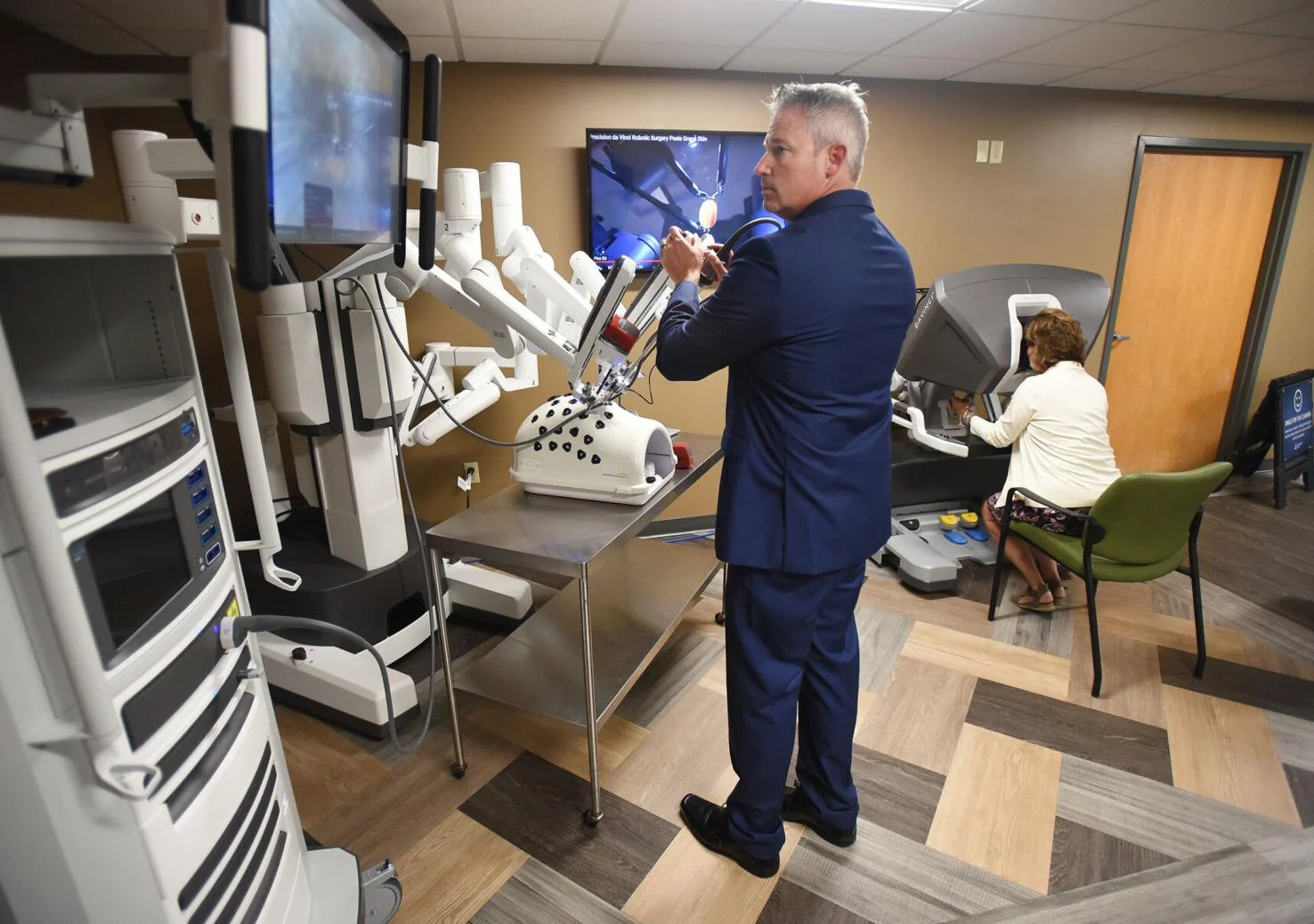Published on August 04, 2023
Muhlenberg Hospital Introduces Facility's First Robotic-assisted Surgery System
By Freddie Bourne Messenger-Inquirer

On Thursday, Owensboro Health Muhlenberg Community Hospital announced its recent acquisition of the robotic-assisted da Vinci Xi Surgical System — to be used for minimally-invasive care for gynecology, urology, thoracic and cardiac surgeries — with an in-person open house and hands-on demonstration.
The system, designed by Intuitive Surgical, Inc., which develops, manufactures and markets robotic products to help improve clinical outcomes through minimally invasive surgery, translates a surgeon’s hand movements at a console in real-time by bending and rotating the instruments while performing a procedure, according to Intuitive’s website.
Crystal Mills, director of surgical services at OHMCH, said bringing the system on board is important for the hospital and its patients.
“This is the first one we have here in this facility,” she said. “It’s an alternative to minimally-invasive laparoscopy procedures and some procedures that would have had to be performed openly, like a larger incision.”
Mills said the system was first used at the hospital on July 28 for a robotic-assisted laparoscopic cholecystectomy, or removal of a gallbladder, performed by Joe Muradov, MD, general surgeon at the hospital — whom she said championed bringing the system to the facility.
“To do successful up-to-date surgeries with minimal complications, good patient outcomes (and) let the patients recover fast, you need to have the appropriate tools, ” said Muradov, currently the only surgeon to use the machine.
“This is the most up-to-date tool which exists in the surgery world at the moment; and knowing all other modalities, including open surgeries, laparoscopic surgeries, I thought that moving forward we will need to bring our hospital to the next generation ….”
The hospital secured the system with funding from various organizations such as the Owensboro Health Foundation providing $400,000, the Felix E. Martin, Jr. Foundation providing $200,000, The Community Hospital, Inc. providing $200,000, and OH providing the remainder — approximately $1 million according to a press release.
Though the system is technology-centric, surgeons still have “100% control” as it’s “robotic- assisted,” according to Muradov, as it translates hand movements into smaller and more precise movements of tiny instruments inside a patient’s body. “It doesn’t take the responsibility from the surgeon,” Muradov laughed. “It’s a surgeon who does the procedure with the help of the robot.”
Mills and Muradov said some benefits of using the system include faster recovery times and healing processes, while it can also help attract potential doctors and specialists to the facility.
“Honestly, a lot of the new doctors that are coming out of school (are) being trained on (something like this), and their experiences are more robotic versus laparoscopic,” she said. “We’re really anticipating it to be a draw for physicians to our community based on the availability of being able to use the robot.”
“... It (can help) bring the specialists who can use this technology like urologists, gynecologists, additional general surgeons who will use it as well,” Muradov said.
Mills said the robot can be helpful for a doctor like Muradov in terms of lessening physical fatigue when performing procedures.
“When he’s able to back away from the OR table instead of standing over (patients) with his head down (and having) the strain on his spine and neck, he’s able to position the (robotic) arms and sit at the console (as) he’s literally is just (doing) small hand movements,” she said.
“That’s less wear and tear on his body … (and get) more longevity of his practice.” Muradov emphasized the importance of being able to operate on a patient with a better view with the 3DHD vision system that’s included, which allows surgeons to have a magnified view of procedures being performed.
Mills finds that many patients are looking to have the newer technology and is glad to be able to have the system. “(Patients are) looking to have this robotic procedure because of the less
bleeding, the less time being out … and they’re actually asking if (we) do the robotic procedure here
…,” she said. “By us now being able to say ‘yes,’ (it’s) going to keep a lot of people in our community here close to home and their family doesn’t have to travel far, or go spend the night with someone at (the) hospital, or have to pick them up.
About Owensboro Health
Owensboro Health is a nonprofit health system with a mission to heal the sick and to improve the health of the communities it serves in Kentucky and Indiana. The system includes Owensboro Health Regional Hospital, nationally recognized for design, architecture and engineering; Owensboro Health Muhlenberg Community Hospital; Owensboro Health Twin Lakes Medical Center; the Owensboro Health Medical Group comprised of over 350 providers at more than 30 locations; four outpatient Healthplex facilities, a certified medical fitness facility, the Healthpark; a weight management program, and the Mitchell Memorial Cancer Center.
On average each year, we have more than 19,000 inpatient admissions, deliver 2,000 babies and provide the region’s only Level III NICU. Owensboro Health physicians perform nearly 33,000 surgical procedures, including nearly 150 open-heart surgeries. Our physicians and staff have 90,000 Emergency Department visits and more than 1.25 million outpatient visits annually. Visit our home page for more information.